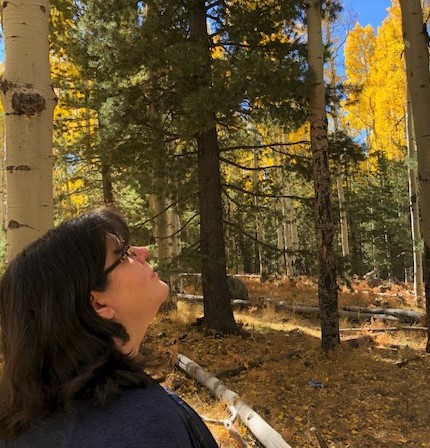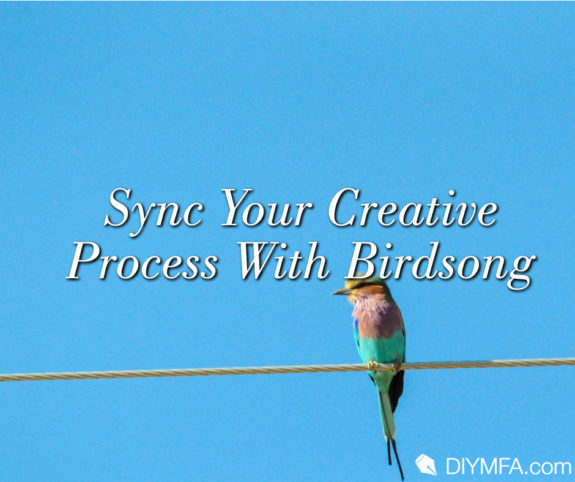I listen to birdsong first thing in the morning while the coffee is brewing. Stepping out on the front porch to listen, I laugh out loud at the insistent squeak of the pileated woodpecker as he makes his loopy flight to the palm tree. I smile at the cheerful songs of the curve-billed thrasher and his determination to sing no matter what the weather.
At dusk I listen to the birds tucking in for the night. Their chatter is loud but not quite as loud as the morning. Hearing the birds wind down from the day signals my mind to likewise slow down for the night. My stress levels calm down on days my internal clock is synced to birdsong at dawn and dusk.
I feel like a part of my day is missing if I don’t hear the birds sing. I start the day relaxed and centered, and my observational skills are sharper. This is the perfect time to start listening. Spring is prime time for males to show off in hopes of attracting a mate. Birdsong is in full swing.
Why does birdsong relax the brain?
Our brains love predictable patterns. Knowing what is next in a pattern helps settle the mind into a groove so that everything is in sync. An example is the A-B-A pattern in music. Even if you aren’t a musician you subconsciously learn and anticipate what comes next with the structure of verse-chorus-verse. Fractals in nature, such as the repeating patterns of the leaf mimicking the structure of the tree, relax our minds in a similar way.
Tai Chi is also a restorative series of repeating patterns. I learned and now teach the forms by repeating these patterns. With each repetition a new circuit is created in the brain. Over time muscle memory takes over. This frees my creative energy to flow and my brain to percolate ideas in the background. My students love the soundtrack of birdsongs I play during class.
Birds create their own songs with a set series of patterns. When you listen to birds in your neighborhood you get familiar with these patterns and anticipate them. The white winged dove always sings woo-woo-ho-hoo. The pygmy nuthatch sings in monotones of peep-peep-peep. The owls talk across the trees by saying hoo, hoo-hoo, hoo, hoo.
On days when I am stuck or life events have pulled me away from writing, listening to birdsong hits the reset button and reframes my mind in a setting outside my inner monologue. The birds don’t care if that sentence didn’t work or I’m behind on a deadline. This time spent simply listening anchors me in a present place. It also gives my brain a rest to process and connect ideas.
How does listening to it help my writing?
I started this daily ritual after hearing nature writer David George Haskell advise other nature writers to go outside and just listen before writing a single word. It is now as much a part of my life routine as it is my writing routine.
I’ve learned from observation that birds start singing at dawn, get louder at daybreak, and go quiet when the sun is fully up. With daily practice I now anticipate who will be singing first and when others will join in the chorus. The curve-billed thrasher is the last to sing. Once he goes quiet, so does everyone else.
I love mysteries, and solving puzzles of bird behavior sparks my imagination. When the birds suddenly stop singing I look for clues to solve the mystery, such as a hawk on top of a nearby lamp post or a sudden shift in the weather. Connecting these cause-and-effect elements in nature translate to developing subplots that drive the main plot forward.
Listening to birdsong improves concentration. Your brain adapts to focus on just one thing. At first you only hear the main notes. After you recognize this pattern you’ll start to hear the in-between notes too. Many characters and plot developments in my book were inspired by observing what was happening in the landscapes around me.
Paying attention to birdsong also helps with world building. You notice things you often overlook: the plants and trees in your area, the weather conditions, daylight or darkness, what the wind is doing, or how sound travels in different conditions. Taking in these details subconsciously helps your brain with the setting of your story.
Listening also helps with story structure. Starling songs are the shining example. Like a three-act story arc, their songs have a beginning of tea kettle-like whistles, something improvised in between, and a whistled crescendo at the end. The improvisation of a curve-billed thrasher might seem without any structure at first. In time, though, you learn the patterns and inflections of this bird’s song and the story he is telling. Sometimes these stories are warnings, and other times they are news reports.
We share 50 genes with birds related to vocal learning. Young birds learn songs from adult birds in the same way that human infants learn words from human adults. Both learn by a repetition of sounds, leading to a sequence of sounds that communicate meaning.
What are some best practices in listening to birdsong?
Ideally you want to listen sometime between dawn and sunrise. If this doesn’t fit in your morning routine you can also listen at dusk. Start with one bird and listen to that one bird’s song for a couple of weeks. Over time you will hear other notes in the song.
Once you are familiar with this one bird, start paying attention to the other layers of birds’ songs. With each day of practice you’ll hear who joins in at what time. Imagine their world. What are they saying, and why? Once you are tuned in to birdsong, you will hear it everywhere!
If weather prevents you from being outside, you can find wonderful soundscapes on Soundcloud. While writing I concentrate best when listening to soundscapes. I mostly listen to places familiar to me but occasionally I try something new. Bird songs from other parts of the world can sound so foreign that it’s like listening to science fiction.
Remember that it takes 30 days to create a habit. Right now is the perfect time to begin. Start with simply walking outside at a set time each day and listening. In time you will know who is singing what and why. Let the birdsong sync your mind and awaken your senses.

Ambre Dawn Leffler is a Tai Chi instructor, gardener, and weather geek who writes about vegetables, seasons, communing with nature, and the interconnections of mind/body. She loves trees and cherishes time in their presence. Learn more about her tree time, garden residents, and wellness practices at her website ambredawnleffler.com and seasonal inspiration from her newsletter.







